Abstract
1. The effects of the metabotropic glutamate receptor (mGluR) antagonist, L-2-amino-3-phosphonopropionate (L-AP3) on phosphoinositide turnover in neonatal rat cerebral cortex slices has been investigated. 2. At concentrations of < or = 300 microM, L-AP3 inhibited total [3H]-inositol phosphate ([3H]-InsPx) and Ins(1,4,5)P3 mass responses stimulated by the selective mGluR agonist, 1-amino-cyclopentane-1S, 3R-dicarboxylic acid (1S, 3R-ACPD). Comparison with the competitive mGluR antagonist (+/-)-alpha-methyl-4-carboxyphenylglycine ((+/-)-MCPG) clearly demonstrated that L-AP3 caused inhibition by a mechanism that was not competitive, as L-AP3 decreased the maximal response to 1S, 3R-ACPD (by approximately 40% at 300 microM L-AP3) without significantly affecting the concentration of 1S, 3R-ACPD required to cause half-maximal stimulation of the [3H]-InsPx response. 3. In contrast, at a higher concentration L-AP3 (1 mM) caused a large increase in [3H]-InsPx accumulation which was similar in magnitude in both the absence and presence of 1S, 3R-ACPD (300 microM). D-AP3 (1 mM) had no stimulatory effect alone and did not affect the response evoked by 1S, 3R-ACPD. L-AP3 (1 mM) also caused a large increase in Ins(1,4,5)P3 accumulation. The magnitude of the response (4-5 fold increase over basal) approached that evoked by a maximally effective concentration of 1S, 3R-ACPD, but differed substantially in the time-course of the response. The stimulatory effects of 1S, 3R-ACPD and L-AP3 on Ins(1,4,5)P3 accumulation were also similarly affected by decreases in extracellular calcium concentration. 4. Detailed analysis of the inositol phospholipid labelling pattern and the inositol (poly)phosphate isomeric species generated following addition of L-AP3 was also performed. In the continued presence of myo-[3H]-inositol, L-AP3 (1 mM) stimulated a significant increase in phosphatidylinositol labelling, but not that of the polyphosphoinositides, and the inositol (poly)phosphate profile suggested that substantial Ins(1,4,5)P3 metabolism occurs via both 5-phosphatase and 3-kinase routes. 5. A significant stimulatory effect of L-AP3 (1 mM) on [3H]-InsPx accumulation was also observed in neonatal rat hippocampus, and cerebral cortex and hippocampus slices prepared from adult rat brain. 6. These data demonstrate that whilst L-AP3 antagonizes mGluR-mediated phosphoinositide responses at concentrations of < or = 300 microM, higher concentrations substantially stimulate this response. The ability of (+/-)-MCPG (1 mM) to attenuate significantly L-AP3-stimulated [3H]-InsPx accumulation, suggests that both the inhibitory and stimulatory effects of L-AP3 may be mediated by mGluRs.
Full text
PDF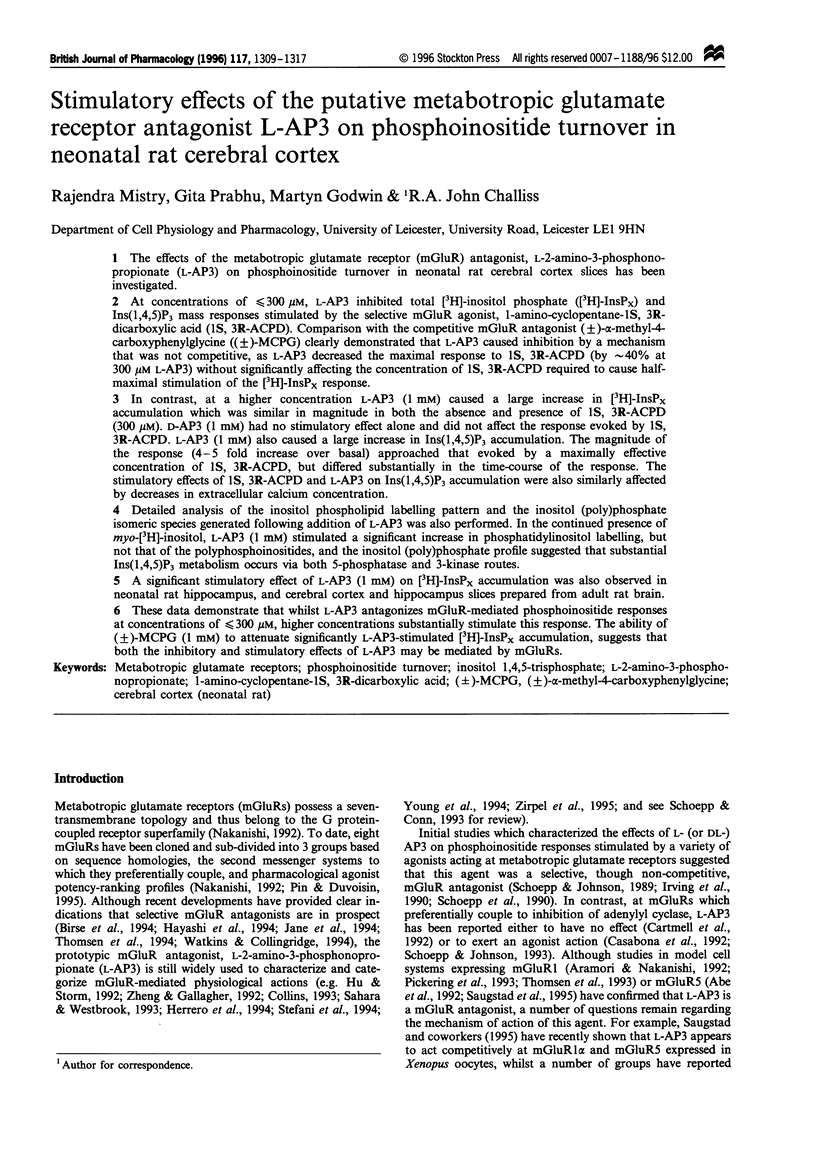



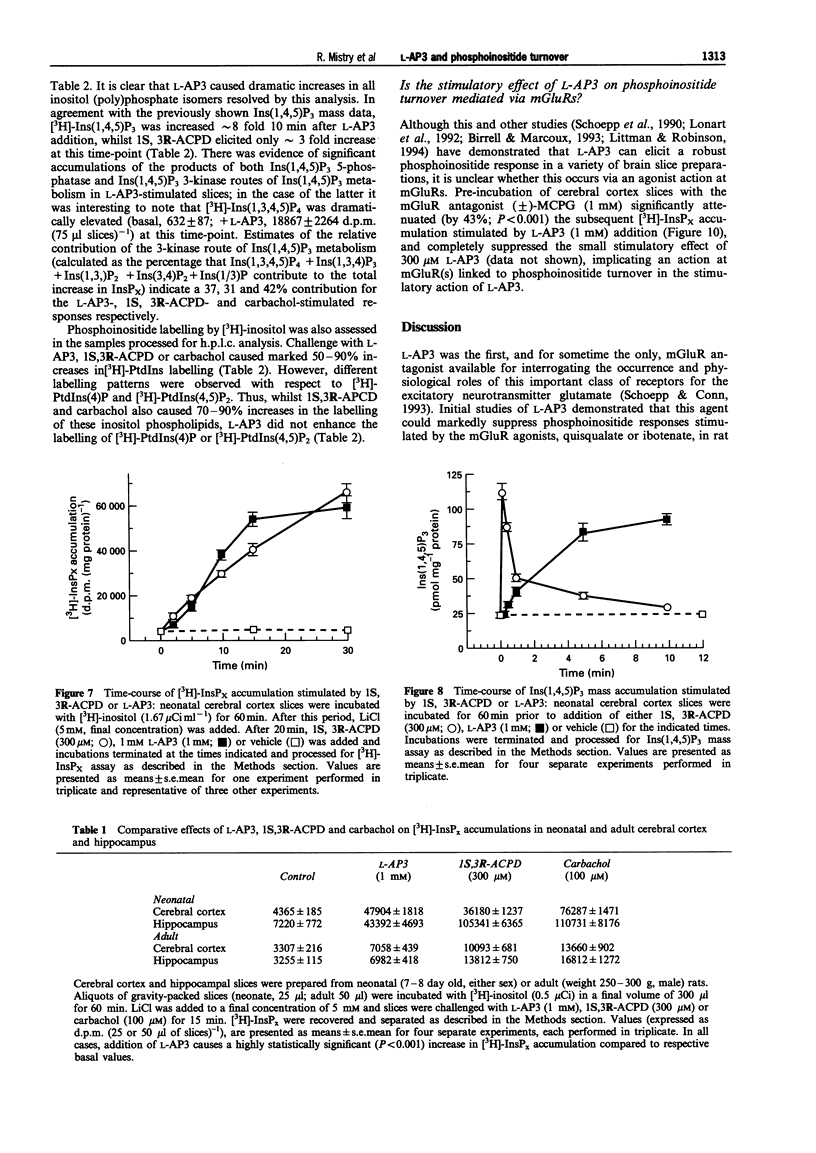
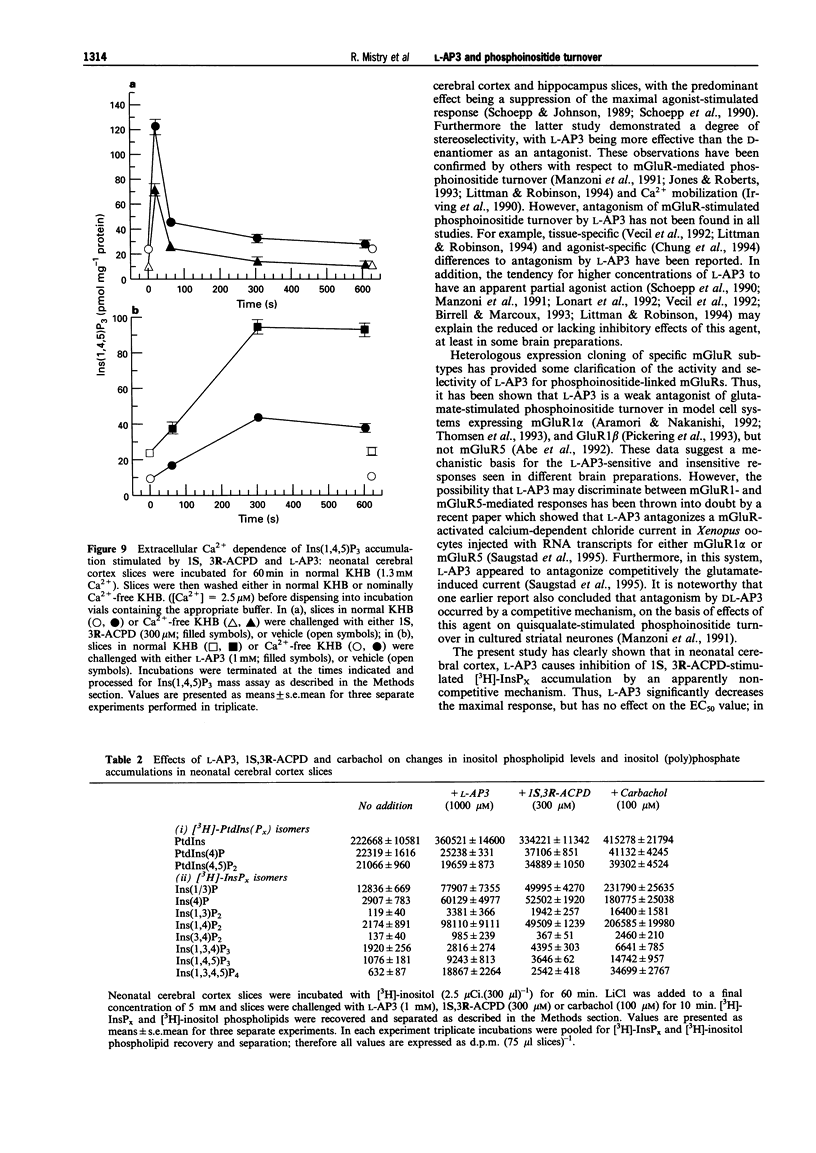
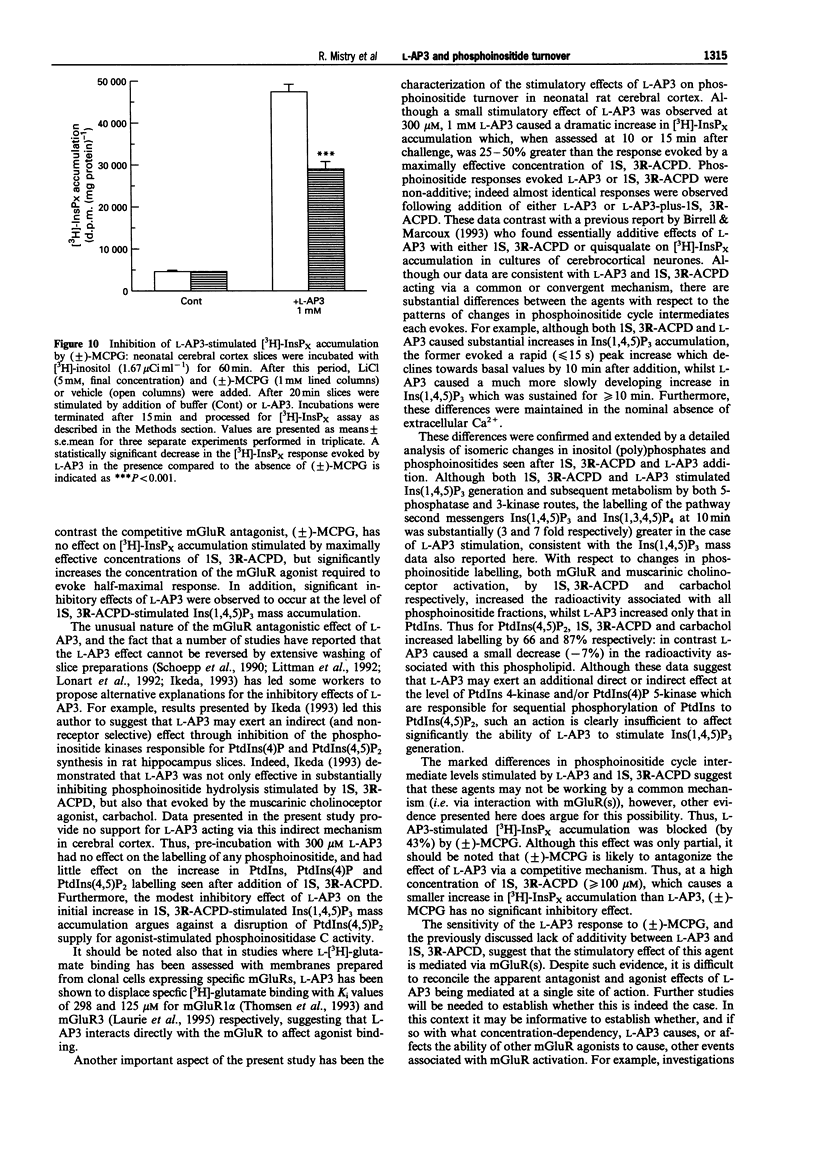
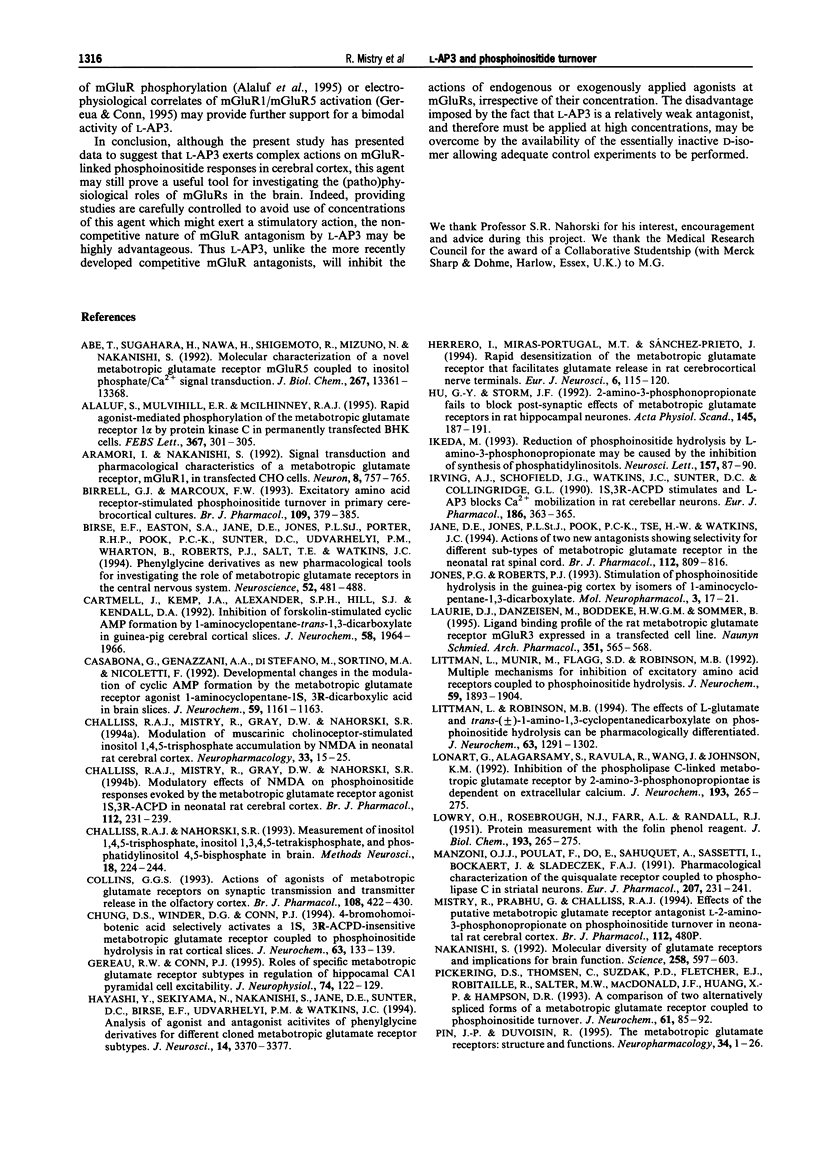

Selected References
These references are in PubMed. This may not be the complete list of references from this article.
- Abe T., Sugihara H., Nawa H., Shigemoto R., Mizuno N., Nakanishi S. Molecular characterization of a novel metabotropic glutamate receptor mGluR5 coupled to inositol phosphate/Ca2+ signal transduction. J Biol Chem. 1992 Jul 5;267(19):13361–13368. [PubMed] [Google Scholar]
- Alaluf S., Mulvihill E. R., McIlhinney R. A. Rapid agonist mediated phosphorylation of the metabotropic glutamate receptor 1 alpha by protein kinase C in permanently transfected BHK cells. FEBS Lett. 1995 Jul 3;367(3):301–305. doi: 10.1016/0014-5793(95)00575-t. [DOI] [PubMed] [Google Scholar]
- Aramori I., Nakanishi S. Signal transduction and pharmacological characteristics of a metabotropic glutamate receptor, mGluR1, in transfected CHO cells. Neuron. 1992 Apr;8(4):757–765. doi: 10.1016/0896-6273(92)90096-v. [DOI] [PubMed] [Google Scholar]
- Birrell G. J., Marcoux F. W. Excitatory amino acid receptor-stimulated phosphoinositide turnover in primary cerebrocortical cultures. Br J Pharmacol. 1993 Jun;109(2):379–385. doi: 10.1111/j.1476-5381.1993.tb13580.x. [DOI] [PMC free article] [PubMed] [Google Scholar]
- Birse E. F., Eaton S. A., Jane D. E., Jones P. L., Porter R. H., Pook P. C., Sunter D. C., Udvarhelyi P. M., Wharton B., Roberts P. J. Phenylglycine derivatives as new pharmacological tools for investigating the role of metabotropic glutamate receptors in the central nervous system. Neuroscience. 1993 Feb;52(3):481–488. doi: 10.1016/0306-4522(93)90400-a. [DOI] [PubMed] [Google Scholar]
- Cartmell J., Kemp J. A., Alexander S. P., Hill S. J., Kendall D. A. Inhibition of forskolin-stimulated cyclic AMP formation by 1-aminocyclopentane-trans-1,3-dicarboxylate in guinea-pig cerebral cortical slices. J Neurochem. 1992 May;58(5):1964–1966. doi: 10.1111/j.1471-4159.1992.tb10077.x. [DOI] [PubMed] [Google Scholar]
- Casabona G., Genazzani A. A., Di Stefano M., Sortino M. A., Nicoletti F. Developmental changes in the modulation of cyclic AMP formation by the metabotropic glutamate receptor agonist 1S,3R-aminocyclopentane-1,3-dicarboxylic acid in brain slices. J Neurochem. 1992 Sep;59(3):1161–1163. doi: 10.1111/j.1471-4159.1992.tb08360.x. [DOI] [PubMed] [Google Scholar]
- Challis R. A., Mistry R., Gray D. W., Nahorski S. R. Modulation of muscarinic cholinoceptor-stimulated inositol 1,4,5-trisphosphate accumulation by N-methyl-D-aspartate in neonatal rat cerebral cortex. Neuropharmacology. 1994 Jan;33(1):15–25. doi: 10.1016/0028-3908(94)90092-2. [DOI] [PubMed] [Google Scholar]
- Challiss R. A., Mistry R., Gray D. W., Nahorski S. R. Modulatory effects of NMDA on phosphoinositide responses evoked by the metabotropic glutamate receptor agonist 1S,3R-ACPD in neonatal rat cerebral cortex. Br J Pharmacol. 1994 May;112(1):231–239. doi: 10.1111/j.1476-5381.1994.tb13057.x. [DOI] [PMC free article] [PubMed] [Google Scholar]
- Chung D. S., Winder D. G., Conn P. J. 4-Bromohomoibotenic acid selectively activates a 1-aminocyclopentane-1S,3R-dicarboxylic acid-insensitive metabotropic glutamate receptor coupled to phosphoinositide hydrolysis in rat cortical slices. J Neurochem. 1994 Jul;63(1):133–139. doi: 10.1046/j.1471-4159.1994.63010133.x. [DOI] [PubMed] [Google Scholar]
- Collins G. G. Actions of agonists of metabotropic glutamate receptors on synaptic transmission and transmitter release in the olfactory cortex. Br J Pharmacol. 1993 Feb;108(2):422–430. doi: 10.1111/j.1476-5381.1993.tb12820.x. [DOI] [PMC free article] [PubMed] [Google Scholar]
- Gereau R. W., 4th, Conn P. J. Roles of specific metabotropic glutamate receptor subtypes in regulation of hippocampal CA1 pyramidal cell excitability. J Neurophysiol. 1995 Jul;74(1):122–129. doi: 10.1152/jn.1995.74.1.122. [DOI] [PubMed] [Google Scholar]
- Hayashi Y., Sekiyama N., Nakanishi S., Jane D. E., Sunter D. C., Birse E. F., Udvarhelyi P. M., Watkins J. C. Analysis of agonist and antagonist activities of phenylglycine derivatives for different cloned metabotropic glutamate receptor subtypes. J Neurosci. 1994 May;14(5 Pt 2):3370–3377. doi: 10.1523/JNEUROSCI.14-05-03370.1994. [DOI] [PMC free article] [PubMed] [Google Scholar]
- Herrero I., Miras-Portugal M. T., Sánchez-Prieto J. Rapid desensitization of the metabotropic glutamate receptor that facilitates glutamate release in rat cerebrocortical nerve terminals. Eur J Neurosci. 1994 Jan 1;6(1):115–120. doi: 10.1111/j.1460-9568.1994.tb00253.x. [DOI] [PubMed] [Google Scholar]
- Hu G. Y., Storm J. F. 2-Amino-3-phosphonopropionate fails to block postsynaptic effects of metabotropic glutamate receptors in rat hippocampal neurones. Acta Physiol Scand. 1992 Jun;145(2):187–191. doi: 10.1111/j.1748-1716.1992.tb09354.x. [DOI] [PubMed] [Google Scholar]
- Ikeda M. Reduction of phosphoinositide hydrolysis by L-amino-3-phosphonopropionate may be caused by the inhibition of synthesis of phosphatidylinositols. Neurosci Lett. 1993 Jul 9;157(1):87–90. doi: 10.1016/0304-3940(93)90649-6. [DOI] [PubMed] [Google Scholar]
- Irving A. J., Schofield J. G., Watkins J. C., Sunter D. C., Collingridge G. L. 1S,3R-ACPD stimulates and L-AP3 blocks Ca2+ mobilization in rat cerebellar neurons. Eur J Pharmacol. 1990 Sep 21;186(2-3):363–365. doi: 10.1016/0014-2999(90)90462-f. [DOI] [PubMed] [Google Scholar]
- Jane D. E., Jones P. L., Pook P. C., Tse H. W., Watkins J. C. Actions of two new antagonists showing selectivity for different sub-types of metabotropic glutamate receptor in the neonatal rat spinal cord. Br J Pharmacol. 1994 Jul;112(3):809–816. doi: 10.1111/j.1476-5381.1994.tb13151.x. [DOI] [PMC free article] [PubMed] [Google Scholar]
- LOWRY O. H., ROSEBROUGH N. J., FARR A. L., RANDALL R. J. Protein measurement with the Folin phenol reagent. J Biol Chem. 1951 Nov;193(1):265–275. [PubMed] [Google Scholar]
- Laurie D. J., Danzeisen M., Boddeke H. W., Sommer B. Ligand binding profile of the rat metabotropic glutamate receptor mGluR3 expressed in a transfected cell line. Naunyn Schmiedebergs Arch Pharmacol. 1995 May;351(5):565–568. doi: 10.1007/BF00171050. [DOI] [PubMed] [Google Scholar]
- Littman L., Munir M., Flagg S. D., Robinson M. B. Multiple mechanisms for inhibition of excitatory amino acid receptors coupled to phosphoinositide hydrolysis. J Neurochem. 1992 Nov;59(5):1893–1904. doi: 10.1111/j.1471-4159.1992.tb11025.x. [DOI] [PubMed] [Google Scholar]
- Littman L., Robinson M. B. The effects of L-glutamate and trans-(+-)-1-amino-1,3-cyclopentanedicarboxylate on phosphoinositide hydrolysis can be pharmacologically differentiated. J Neurochem. 1994 Oct;63(4):1291–1302. doi: 10.1046/j.1471-4159.1994.63041291.x. [DOI] [PubMed] [Google Scholar]
- Manzoni O. J., Poulat F., Do E., Sahuquet A., Sassetti I., Bockaert J., Sladeczek F. A. Pharmacological characterization of the quisqualate receptor coupled to phospholipase C (Qp) in striatal neurons. Eur J Pharmacol. 1991 Jul 12;207(3):231–241. doi: 10.1016/0922-4106(91)90035-g. [DOI] [PubMed] [Google Scholar]
- Nakanishi S. Molecular diversity of glutamate receptors and implications for brain function. Science. 1992 Oct 23;258(5082):597–603. doi: 10.1126/science.1329206. [DOI] [PubMed] [Google Scholar]
- Pickering D. S., Thomsen C., Suzdak P. D., Fletcher E. J., Robitaille R., Salter M. W., MacDonald J. F., Huang X. P., Hampson D. R. A comparison of two alternatively spliced forms of a metabotropic glutamate receptor coupled to phosphoinositide turnover. J Neurochem. 1993 Jul;61(1):85–92. doi: 10.1111/j.1471-4159.1993.tb03540.x. [DOI] [PubMed] [Google Scholar]
- Pin J. P., Duvoisin R. The metabotropic glutamate receptors: structure and functions. Neuropharmacology. 1995 Jan;34(1):1–26. doi: 10.1016/0028-3908(94)00129-g. [DOI] [PubMed] [Google Scholar]
- Sahara Y., Westbrook G. L. Modulation of calcium currents by a metabotropic glutamate receptor involves fast and slow kinetic components in cultured hippocampal neurons. J Neurosci. 1993 Jul;13(7):3041–3050. doi: 10.1523/JNEUROSCI.13-07-03041.1993. [DOI] [PMC free article] [PubMed] [Google Scholar]
- Saugstad J. A., Segerson T. P., Westbrook G. L. L-2-amino-3-phosphonopropionic acid competitively antagonizes metabotropic glutamate receptors 1 alpha and 5 in Xenopus oocytes. Eur J Pharmacol. 1995 Apr 28;289(2):395–397. doi: 10.1016/0922-4106(95)90120-5. [DOI] [PubMed] [Google Scholar]
- Schoepp D. D., Conn P. J. Metabotropic glutamate receptors in brain function and pathology. Trends Pharmacol Sci. 1993 Jan;14(1):13–20. doi: 10.1016/0165-6147(93)90107-u. [DOI] [PubMed] [Google Scholar]
- Schoepp D. D., Johnson B. G. Inhibition of excitatory amino acid-stimulated phosphoinositide hydrolysis in the neonatal rat hippocampus by 2-amino-3-phosphonopropionate. J Neurochem. 1989 Dec;53(6):1865–1870. doi: 10.1111/j.1471-4159.1989.tb09254.x. [DOI] [PubMed] [Google Scholar]
- Schoepp D. D., Johnson B. G. Pharmacology of metabotropic glutamate receptor inhibition of cyclic AMP formation in the adult rat hippocampus. Neurochem Int. 1993 Mar;22(3):277–283. doi: 10.1016/0197-0186(93)90056-b. [DOI] [PubMed] [Google Scholar]
- Schoepp D. D., Johnson B. G., Smith E. C., McQuaid L. A. Stereoselectivity and mode of inhibition of phosphoinositide-coupled excitatory amino acid receptors by 2-amino-3-phosphonopropionic acid. Mol Pharmacol. 1990 Aug;38(2):222–228. [PubMed] [Google Scholar]
- Stefani A., Pisani A., Mercuri N. B., Bernardi G., Calabresi P. Activation of metabotropic glutamate receptors inhibits calcium currents and GABA-mediated synaptic potentials in striatal neurons. J Neurosci. 1994 Nov;14(11 Pt 1):6734–6743. doi: 10.1523/JNEUROSCI.14-11-06734.1994. [DOI] [PMC free article] [PubMed] [Google Scholar]
- Thomsen C., Boel E., Suzdak P. D. Actions of phenylglycine analogs at subtypes of the metabotropic glutamate receptor family. Eur J Pharmacol. 1994 Mar 15;267(1):77–84. doi: 10.1016/0922-4106(94)90227-5. [DOI] [PubMed] [Google Scholar]
- Thomsen C., Mulvihill E. R., Haldeman B., Pickering D. S., Hampson D. R., Suzdak P. D. A pharmacological characterization of the mGluR1 alpha subtype of the metabotropic glutamate receptor expressed in a cloned baby hamster kidney cell line. Brain Res. 1993 Aug 13;619(1-2):22–28. doi: 10.1016/0006-8993(93)91592-g. [DOI] [PubMed] [Google Scholar]
- Vecil G. G., Li P. P., Warsh J. J. Evidence for metabotropic excitatory amino acid receptor heterogeneity: developmental and brain regional studies. J Neurochem. 1992 Jul;59(1):252–258. doi: 10.1111/j.1471-4159.1992.tb08898.x. [DOI] [PubMed] [Google Scholar]
- Watkins J., Collingridge G. Phenylglycine derivatives as antagonists of metabotropic glutamate receptors. Trends Pharmacol Sci. 1994 Sep;15(9):333–342. doi: 10.1016/0165-6147(94)90028-0. [DOI] [PubMed] [Google Scholar]
- Young M. R., Fleetwood-Walker S. M., Mitchell R., Munro F. E. Evidence for a role of metabotropic glutamate receptors in sustained nociceptive inputs to rat dorsal horn neurons. Neuropharmacology. 1994 Jan;33(1):141–144. doi: 10.1016/0028-3908(94)90109-0. [DOI] [PubMed] [Google Scholar]
- Zheng F., Gallagher J. P. Metabotropic glutamate receptors are required for the induction of long-term potentiation. Neuron. 1992 Jul;9(1):163–172. doi: 10.1016/0896-6273(92)90231-2. [DOI] [PubMed] [Google Scholar]
- Zirpel L., Lachica E. A., Rubel E. W. Activation of a metabotropic glutamate receptor increases intracellular calcium concentrations in neurons of the avian cochlear nucleus. J Neurosci. 1995 Jan;15(1 Pt 1):214–222. doi: 10.1523/JNEUROSCI.15-01-00214.1995. [DOI] [PMC free article] [PubMed] [Google Scholar]


